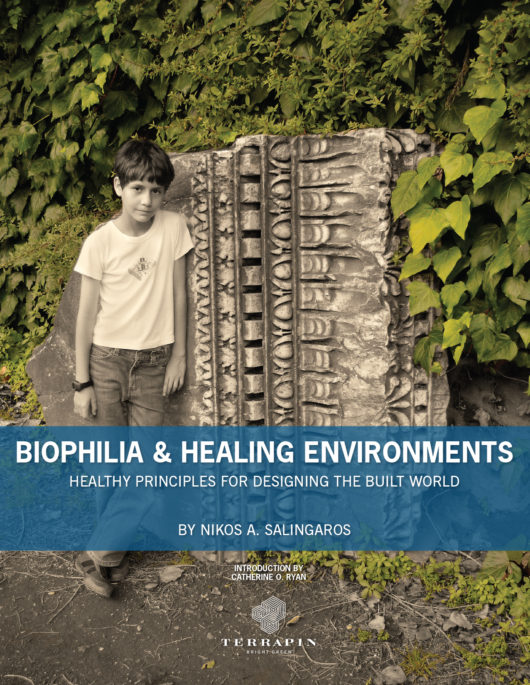Terrapin Report
Biophilia & Healing Environments
Healthy Principles For Designing the Built World
Author
Nikos A. Salingaros, PhD, The University of Texas at San Antonio, Department of Mathematics
Introduction by Catherine O. Ryan, Terrapin Bright Green
Introduction
Terrapin and Metropolis magazine banded together to publish the compilation of essays by Nikos Salingaros. The individual chapters, originally published in Metropolismag.com during August and September of 2015, have been compiled here. Hard copies are available for purchase through offthecommonbooks.com.
Abstract
Our biology should dictate the design of the physical settings we inhabit. As human beings, we need to connect with living structures in our environment. Designers thus face the task of better incorporating healing strategies into their work, using factors that contribute to the biophilic effect. 17th, 18th, 19th, and some 20th century architecture show the healing traits of biophilia. After that, architects ignored complex human responses to the built environment in their enthusiasm for the supposed mechanical efficiencies of the industrial approach to placemaking. Design that uses biophilia considers the inclusive, “bottom-up” processes needed to sustain our health. When ornament is coherent with the rest of a structure, it helps connect people to their environment, and creates a positive, healing atmosphere. Biophilia shows how our evolutionary heritage makes us experience buildings viscerally, and not as intellectualized abstractions. This thinking juxtaposes the focus on innovative form for its own sake with biophilic design.
Contents
INTRODUCTION, by Catherine O. Ryan
- Why we should be living in “living” houses
- What do light, color, gravity, and fractals have to do with our well-being?
Table 1. Eight points of the biophilic effect
- What kind of design triggers healing?
- Modern architecture tells an incomplete story
- What do historic buildings say about our connection to the natural world?
- The growing demand for spaces that consider our health
- Why do we create ornament to mimic nature?
Table 2. Cognitive rules for ornament
- Modernist minimalism and our relationship with our buildings
- The importance of listening to lessons from nature
- Why we hug the edge of open spaces
Table 3. Patterns that determine paths
ENDNOTE
APPENDIX: Two meanings of biophobia as obstacles to biophilia.
FURTHER READING
REFERENCES

